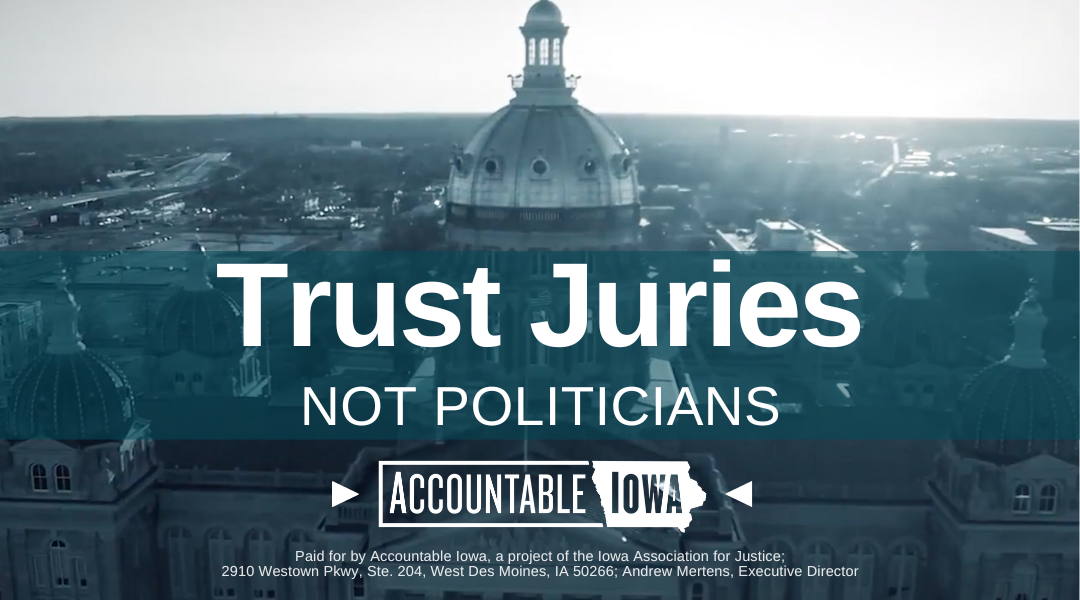As I have been saying for days, Joe Biden is not legally President-Elect. Per the Constitution, the President-Elect is not chosen until Electors meet and cast votes in their respective State Capitols in December, followed by Congress certifying propriety of those votes in early January.
Preliminarily, however, does Joe Biden appear to have secured the 270 electors necessary to win the December Electoral College election, and without controversy with respect to Congressional certification in early January, prior to the Inauguration date? The answer, no. Even respected Real Clear Politics has Biden at only 259.
Why? Pennsylvania. As I also have been saying, the media call for Biden in Pennsylvania was rushed and premature. The huge problem is the illegitimate late votes added to totals, and the veracity and legitimacy of the distribution allocation of those votes as recorded.
Pennsylvania Supreme Court erroneously ruled prior to Election that votes coming in after the Legislative deadline could be counted, and that signatures did not need to match.
But this is an overreach of Legislative authority and will be overturned.
Many other states, in order to ensure the respective rights of their own citizens from an equal protection Constitutional standpoint, have sued Pennsylvania to overturn the Pennsylvania Supreme Court’s illegal ruling.
Justice Alito, in a foreboding sign for these late, non-qualifying Biden votes, has ordered a set-aside/segregation of all votes coming in after 8 p.m. on election night, and thus illegal votes.
Furthermore, with that post-8 p.m. time deadline for reception of ballots, Democrats in Pennsylvania universally forbade the admittance of Republican observers as required by Pennsylvania law. As a result, spoilage of those ballots will be deemed to have occurred.
Whether based upon spoliation or time deadline, 1.3 million ballots were illegally counted late after midnight on election night, of which 1 million were allocated to Biden, erasing Trump’s insurmountable election day lead of 700,000.
Based on Justice Alito’s order to segregate ballots received after 8 p.m election night, the US Supreme Court may follow the law and disqualify those votes.
There also is a concern beyond the mere tardiness of receipt of those votes, according to the mathematical science law called Benford’s Law.
Benford’s Law is often used to flag such things as election fraud, bank embezzling, skimming, etc.
“Benford’s law, also called the Newcomb–Benford law, the law of anomalous numbers, or the first-digit law, is an observation about the frequency distribution of leading digits in many real-life sets of numerical data. The law states that in many naturally occurring collections of numbers, the leading digit is likely to be small.[1] In sets that obey the law, the number 1 appears as the leading significant digit about 30% of the time, while 9 appears as the leading significant digit less than 5% of the time. If the digits were distributed uniformly, they would each occur about 11.1% of the time.[2] Benford’s law also makes predictions about the distribution of second digits, third digits, digit combinations, and so on.”
“It has been shown that this result applies to a wide variety of data sets, including electricity bills, street addresses, stock prices, house prices, population numbers, death rates, lengths of rivers, and physical and mathematical constants.[5] Like other general principles about natural data—for example, the fact that many data sets are well approximated by a normal distribution—there are illustrative examples and explanations that cover many of the cases where Benford’s law applies, though there are many other cases where Benford’s law applies that resist a simple explanation.[6] It tends to be most accurate when values are distributed across multiple orders of magnitude, especially if the process generating the numbers is described by a power-law (which is common in nature).” Ibid.
N.B.: Wikipedia explanatories on Benford found below.
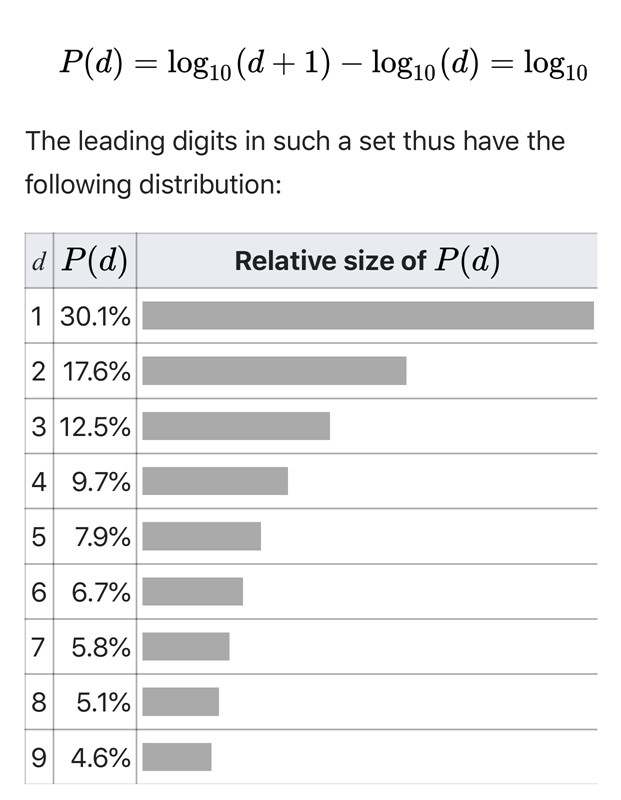
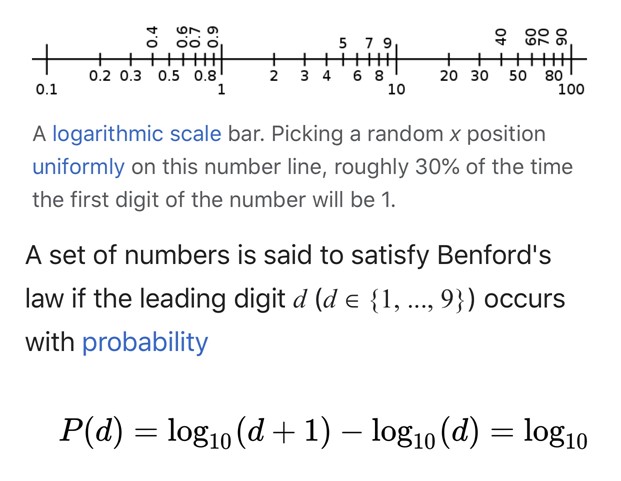
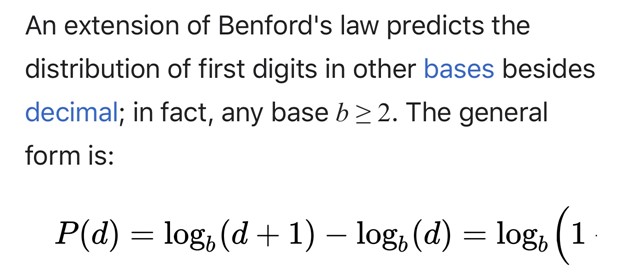
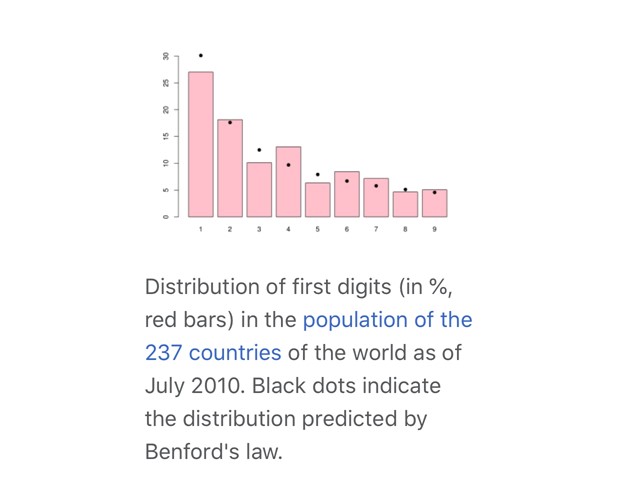
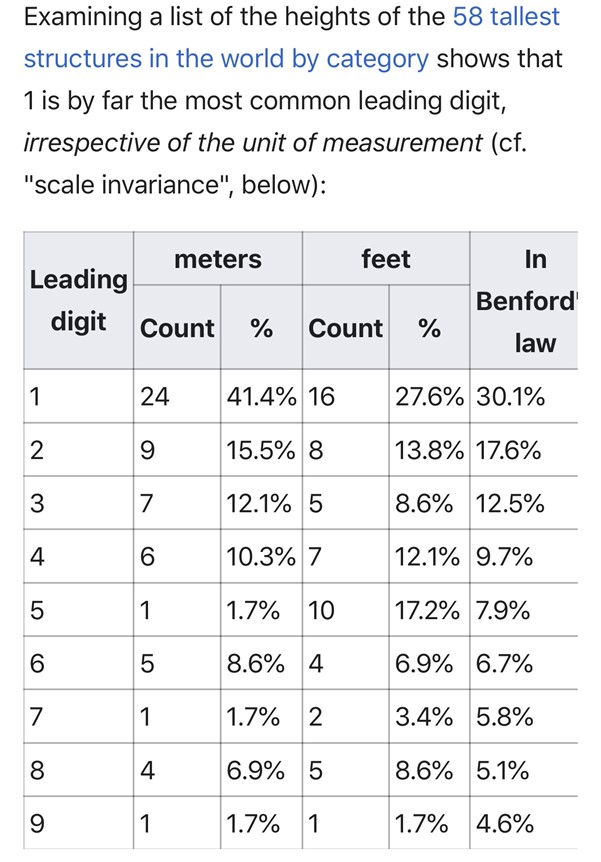
In some Pennsylvania areas, the disproportionate allocation of incoming votes appears to be statistically impossible.
From the Red Elephants: “Some data scientists allege that Biden’s vote tallies in some parts of the country violate Benford’s Law. All of the other candidates’ tallies follow Benford’s law across the country, except for Biden when he gets into some tight races. Benford’s law is one accepted test for catching election fraud, used by the State Department and forensic accountants.”
Check out the graph from Allegheny PA below:
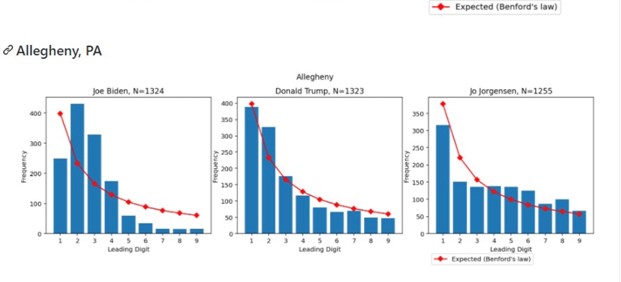
Ibid.
Worse than that, this pattern has been found among all Rust Belt-Great Lakes major Democrat U.S. cities in the critical swing states. For example—
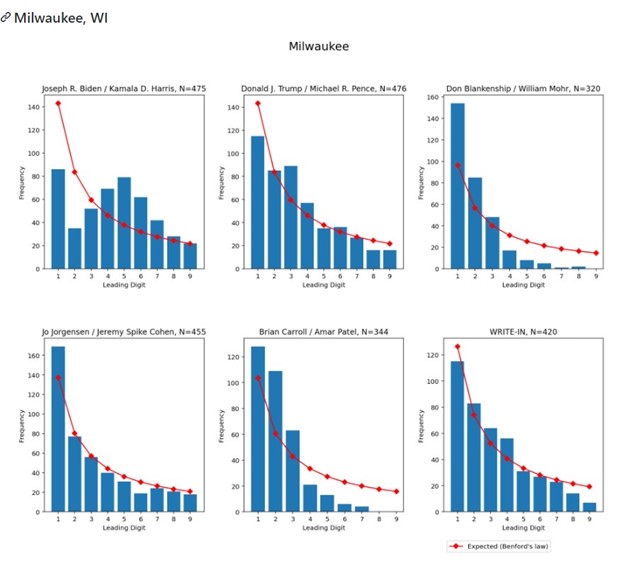
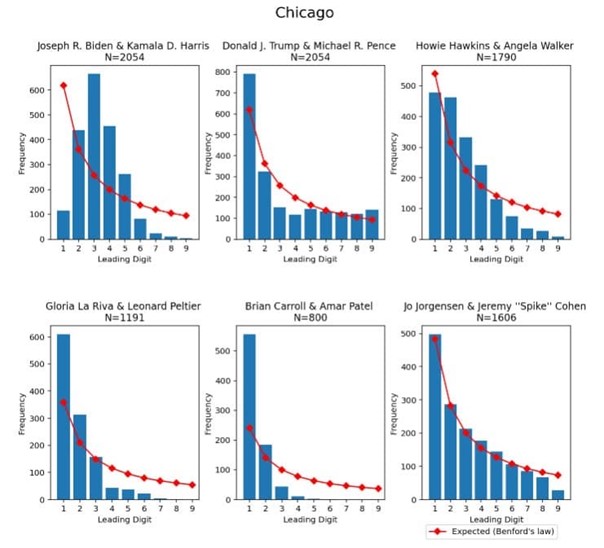
In the aggregate, Biden appears to be violating Benford’s law in major cities in Rust Belt-Great Lakes swing states.
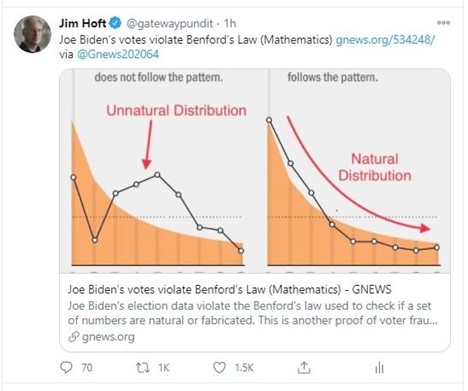
Red Elephants continues: “Analysts previously ran the data with Allegheny absentee ballots specifically, using the Mebane 2nd digit test with Trump vs Biden. In Trump’s there were only 2 deviations but neither were significant at the 5% level. For Biden in Allegheny absentee ballots, there are multiple significant deviations. For Trump, none of the deviations are significant at the 5% level.”
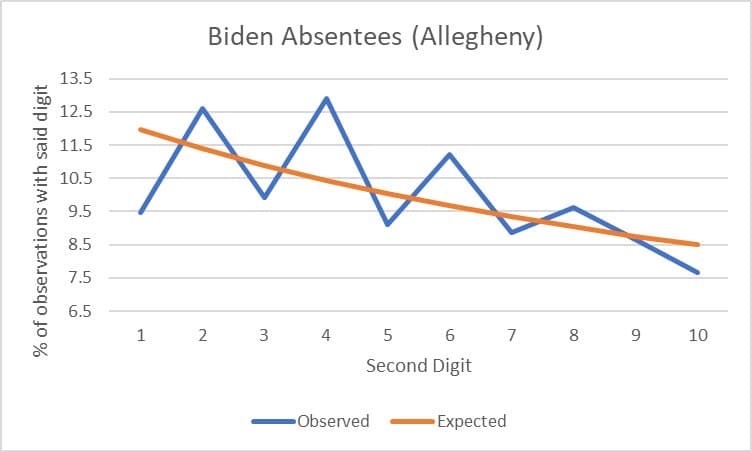
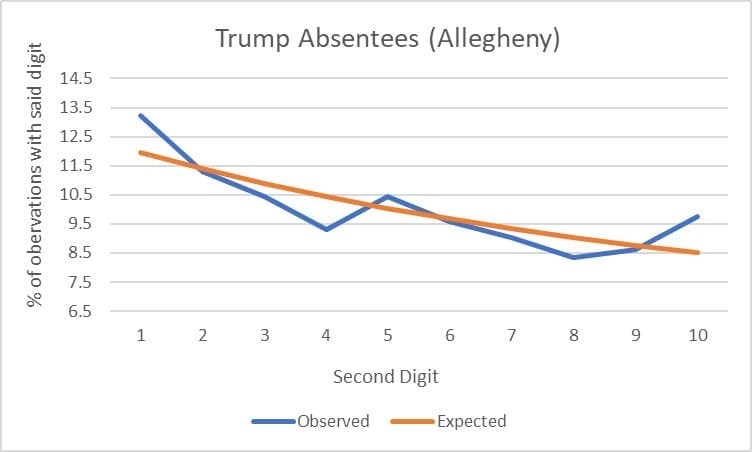
Why is this so important? Standard Deviation. Look at a representation of a typical standard deviation application below. The Biden regression line analysis shows, if you will, wild swings and outliers away from the mean, several standard devitations worth of volatility. As you can see from the chart below, after three standard deviations there is only a 0.01% probability of an event occurring. In decimal format, that is .001.
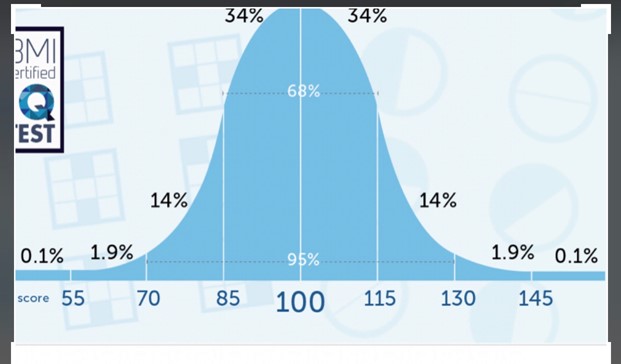
Furthermore, Biden ran well behind in major US cities across the nation in term s of aggregate gross vote totals earned by both Barack Obama in 2008 and 2012, as well as Hillary Clinton in 2016, yet, astoundingly, only ran ahead of those peers in those cities this November that specifically were in Electoral College swing state geographic zones!!
And to compound a bad situation even further: “Ballots in Pennsylvania also seem to be arriving before they’re sent out, arriving the same day, or arriving just one day after being mailed out. A data analyst explains that there are so-called “fast traveling” ballots appearing. Their distribution is skewed towards mail-in applications compared to the rest which are skewed towards online applications. He plotted BallottSentDate vs DallotReturnedDate. And added (BallotSentDate vs BallotSentDate) on the same plot which gave a straight line (1:1). Everything below this line traveled back in time.” Ibid.
“There is a difference in percentage of ’suspicious’ ballots by mail application type. OLMAILV- This is a mail ballot application that was submitted online. MAILIN-This is a mail-in ballot application. ‘Suspicious’ ballots have higher ratio of Mail-In compared to Online than normal ballots. You would expect that under normal circumstances, and if there is a perfectly legal explanation for the ‘suspicious ballots,’ the turnaround time should not depend on how the ballot was requested? Also, table above is colored by %age for “% of Total(Y)” – Y for ‘suspicious.’”—Red Elephants.
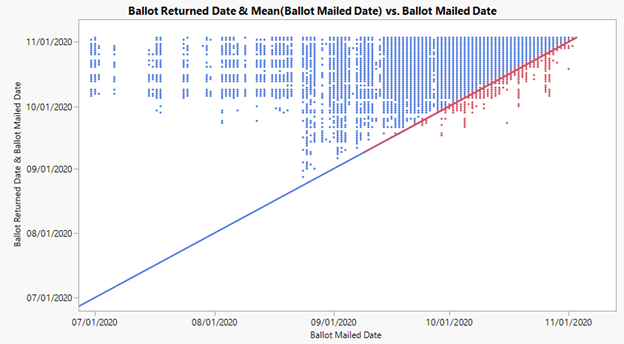

@VC4351: “If only look at those ‘suspicious’ mail-in ballot – most of them come from Philadelphia and Lehigh, around 44%.”
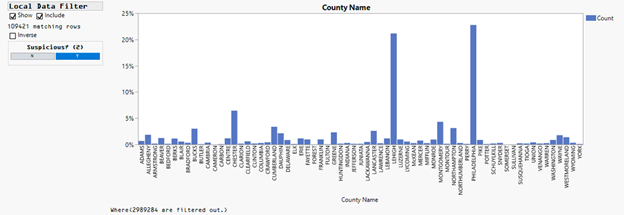
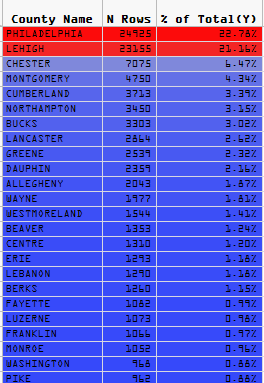
There are various reasons these late-arriving “votes” should be tossed. And they should be tossed. Reason: it’s statistically nearly impossible for this to be a legitimate allocation.
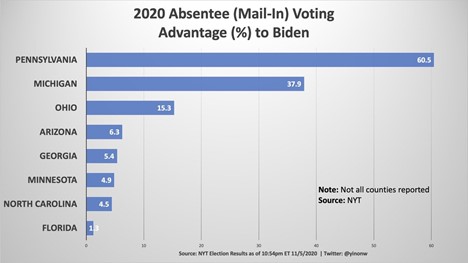
Without those non-signature verified, non-observed, tardily received, sometimes time-traveled over one million statistically non-verifiable vote counts, Trump ends up leading in Pennsylvania, and handily. It’s math. It’s science. It’s statistics. This means this race is far from over. To call it early is cheating and stealing.



